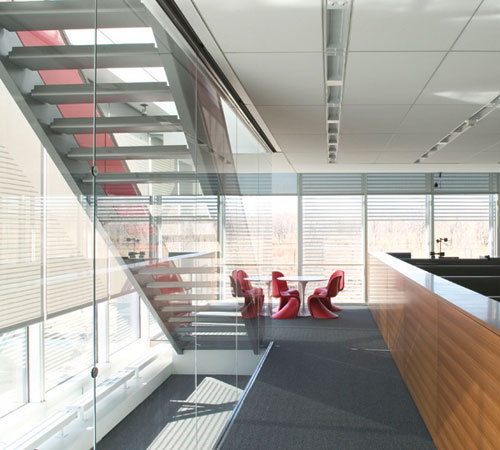Automated Shading and Light Systems
The goals for the shading system are based upon the understanding that in The New York Times Building, daylight is preferred over electric light, so daylight is treated as the primary light source and electric light will be used as a supplement when necessary. To that end, the shading system goals include: maximizing the daylight in the space, avoiding direct solar radiation on the occupants, and maintaining a glare free environment.
An important aspect of the visual environment in an office space is known as the contrast ratio. The contrast ratio describes the relative brightness of the computer screen and the brightness of the backdrop of windows, or, in the case of The New York Times Building, the brightness of the glass curtain wall. When a person is sitting at a desk that is facing out toward the glass curtain wall, that person would see both the computer screen and the curtain wall in the visual field. The ratio must be managed, so that uncomfortable conditions do not arise. The IESNA recommends a ratio of 1:7, where the window should not be more than seven times brighter than the computer screen. The New York Times Building initially relaxed this ratio to 1:10, allowing the exterior curtain wall to be up to 10 times brighter than the computer screen. After occupying the space for awhile, building occupants have requested that the shades be allowed to be open even more, and The New York Times is now considering further relaxing the ratio to allow even more daylight into the space.
System Performance
An automated shading and lighting control system constantly monitors the building's microclimate outdoors and responds in real time, while continuously regulating interior illumination levels. In order to truly appreciate the adaptability of this dynamic daylighting solution, let's discuss the changes the system undergoes in one day of operation.
The amount and type of daylight around a building at any given time is dependent upon three factors: the latitude of the building, the orientation of the building, and the weather conditions of the day. Although the latitude and orientation of a building do not change, as the sun moves throughout the day, the characteristics of the daylight available to that stationary building change. For example, as the sun rises in the morning, east-facing windows receive considerable amounts of direct sunlight. South-facing windows, in general, receive nice amounts of ambient light, but can experience limited exposure to direct sunlight during the afternoon hours. As the sun is setting in the west, west-facing windows receive substantial exposure to direct sunlight.
Here is a play-by-play explanation of how the automated shading and lighting control system manage the sun's movement around The New York Times building, while satisfying illumination targets in the space, every afternoon.
At 2:40 p.m., the shades on the south elevation are deployed to the third position, three-fourths of the way down, and the shades on the western side are adjusted to the first position, one-fourth of the way down. Enough ambient daylight is present in the space to satisfy illumination targets, so the electric lights are completely off.
 |









